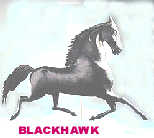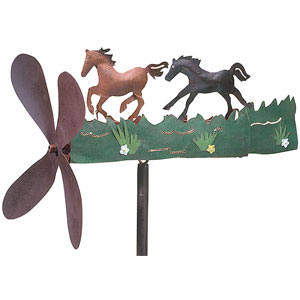|
Horse Weathervanes
|
There's a vexilloid on the barn! By the way, when you purchase a weathervane you've purchased a vexilloid.
A European Tradition
The word "vane" comes from the Anglo-Saxon word "fane", meaning "flag". In medieval Europe fabric pennants or flags were used to indicate wind direction (just like the pennants you find at football stadiums).
Weathervanes featuring a cock (also called weathercocks) made their appearance on the churches of Europe and merchants began to display weathervanes featuring symbols of their business or craft.
This practice eventually found its way to the American colonies becoming a great American tradition.
|
- Paul Revere placed a wooden codfish studded with copper nails for scales above his Boston shop.
- George Washington 's house in Mount Vernon was adorned with a dove weathervane honoring the peace following the Revolutionary War.
- Perhaps the most famous early American weathervane is the grasshopper, the traditional symbol for a merchant, on top of Faneuil Hall in Boston.
- Thomas Jefferson attached the weather vane on Monticello to a pointer in the ceiling of the room directly below, so he could read the direction of the wind from inside his home.
(By the way, the next time you put together of must-visit places in the USA, include a visit to Monticello, it's a truly fascinating place.)

It was the farmers among the early American settlers who began to depart from traditional weathervane designs, creating vanes in the shape of arrows, Indians, eagles, and especially, horse weathervanes. Later, in the mid-nineteenth century the sport of racing trotters became popular with the trotting horse becoming one of the more frequent subjects for the horse weathervanes in that period.
Early horse weathervanes were usually made of copper or wrought iron with the latter eventually replaced by cast iron and later, steel. "Three dimensional' figures were often crafted by hammering copper about a cast iron mold. Of course vanes were also made from wood or any convenient material.
We've seen horse weathervanes fashined from aluminum and stained glass also on the Internet. There's no shortage of places to shop out there. A small number of American craftsmen still make folk art weather vanes if you have tradition in mind.
Two sources we can recommend:
- You'll find several examples in the Back In The Saddle On Line Catalog.
- Our friend and fellow Montanan Jerry Morang (Images of Steel) makes horse weathervanes to your exact specifications (a weathervane showing the silhouette of a favorite horse might be a gift idea worth considering).
Locating and Mounting
- not terribly difficult in most cases. Just be careful - no climbing on wet shingles while wearing cowboy boots!
Weathervanes usually, but not always come mounted on an angle bar that adjusts (hopefully) to match the pitch of the roof. It might be good to ask or take a look to see if there are going to be any problems.
Take a compass with you when you mount it. Not that you have to be all that accurate but neither do you want to climb all the way to the top of the barn and then wander where the heck North is (we once had a vane up for several months before noticing that we had E and W backwards)!
The Whirligig

The term whirligig can be applied to most any whirling or spinning object - a child's top for example.
Whirligigs have been around for several centuries, usually as childrens toys, more often in recent times as kinetic art forms - lawn ornaments.
Here's one we found in the Back In The Saddle On Line Catalog featuring - Gifts and Apparel for Horse Lovers. The Running Horses Whirligig illustrated here is crafted from painted sheet metal and is item number B27750 should you visit the BITS online catalog.
may favorable winds blow your way!

